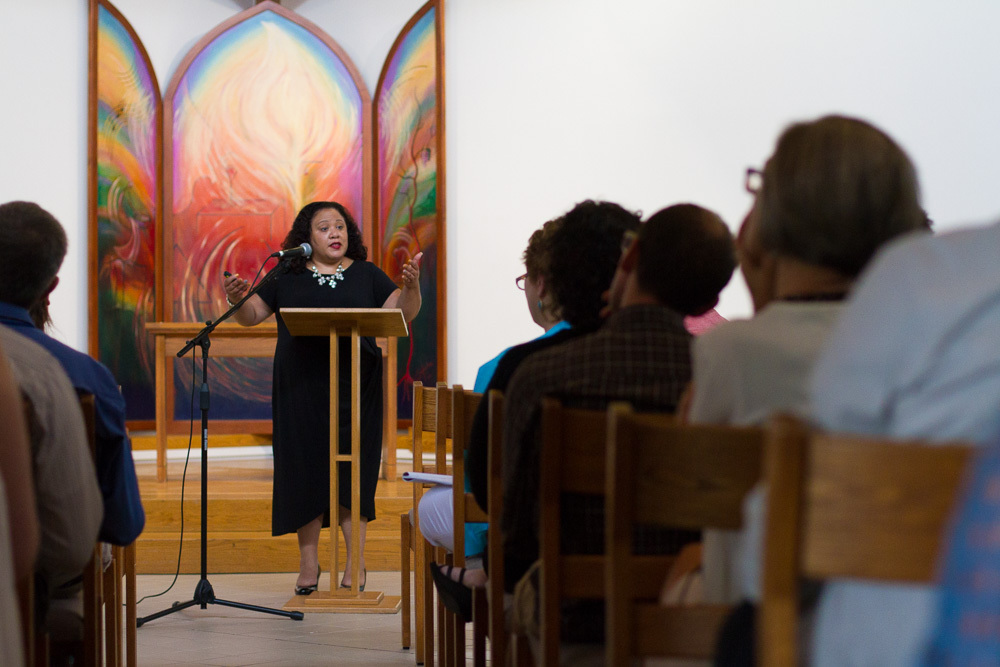As deep racial tensions continued to play out on the national stage, Eastern Mennonite University faculty and staff explored elements of their university’s own history and diversity in a breakout session during the Aug. 15-16 faculty-staff conference.
Professors Mark Sawin and Melody Pannell presented a historical overview, a personal account and general observations relating to diversity titled “Shifting Paradigms, Shifting Power: Diversity and a New Radical Anabaptist Community.”
Before presenting highlights from a timeline of African American inclusion that shows EMU’s increasing diversity, Sawin noted that as a historian, he is “keenly aware” that once a history is written, it is codified and becomes the story. But no historian knows everything or can include every story, he said, and so crafting a historical narrative inevitably silences countless voices and leaves out their experiences and perspectives.
With that limitation in mind, Sawin described aspects of the university’s struggles — and the context of the local and broader Mennonite communities’ struggles — with racial integration and inclusiveness. In 1925, for example, Virginia Mennonite Conference disapproved of marriages and close friendships between races. In the 1930s, though, Eastern Mennonite School students began crossing racial boundaries in their community involvements. In 1949, the first black student enrolled full time at Eastern Mennonite College. Ultimately, EMC would become a forerunner of college integration, and when in 1959 The Richmond Times Dispatch ran a story on six Virginia colleges accepting black students, EMC was declared the first to do so.
Sawin pointed out that tumultuous times such as the Great Depression or after World War II spawned change, which was often initiated not by established leadership but by students and faculty activists.
Fellow presenter Melody Pannell’s own story is very much a part of EMU’s widening diversity. Pannell graduated as one of 70 American students of color from EMU in 1997, and would go on to become the director of the university’s multicultural services and a professor. In her presentation she traced her own story as a Mennonite girl from Harlem, New York.
Pannell’s mother was a plain-dressed conservative Mennonite from a German-Swiss, Pennsylvania Dutch community in Elizabethtown, Pennsylvania. Her father, from Coatesville, Pennsylvania, was an African American who was introduced to the Mennonite church through Newlinville Mennonite Church as a teenager. Later he became the first African American ordained pastor through Lancaster Mennonite Conference at Seventh Avenue Church. They married in 1964 while serving in Harlem.
While her father’s dreams of attending EMC were never fulfilled, Pannell would become “a loyal, supportive, dedicated and active member of the campus community.” It wasn’t easy being biracial at EMU, half “ethnic Mennonite” but still noticeable in Lehman Auditorium in “the sea of straight brown and blond hair, and blue eyes,” and still often treated as “other.” But her admissions counselor had told her, “You need EMU, but EMU needs you,” and she began to believe that her role here would be “an exchange.”
And it would be an exchange. Her professors, she said, cared about her life and trajectory — which is now part of African American people’s own legacies in the story of EMU.
Sawin and Pannell closed the session with several observations about the the EMU community:
- The EMU student body and constituency has changed and will continue to change, and these changes will bring greater diversity.
- EMU is a Mennonite institution with many values and traditions that are important. We have a unique and important voice and mission.
- Progress comes from change, and change has most often been driven by those outside the central power structures.
- Groups that feel comfortable and confident in their identity are better able to engage and embrace new ideas and new groups.

I am thankful for EMU’s diversity.
I have fond memories of my time at EMC/EMU…I wish I could have taken part in this discussion.